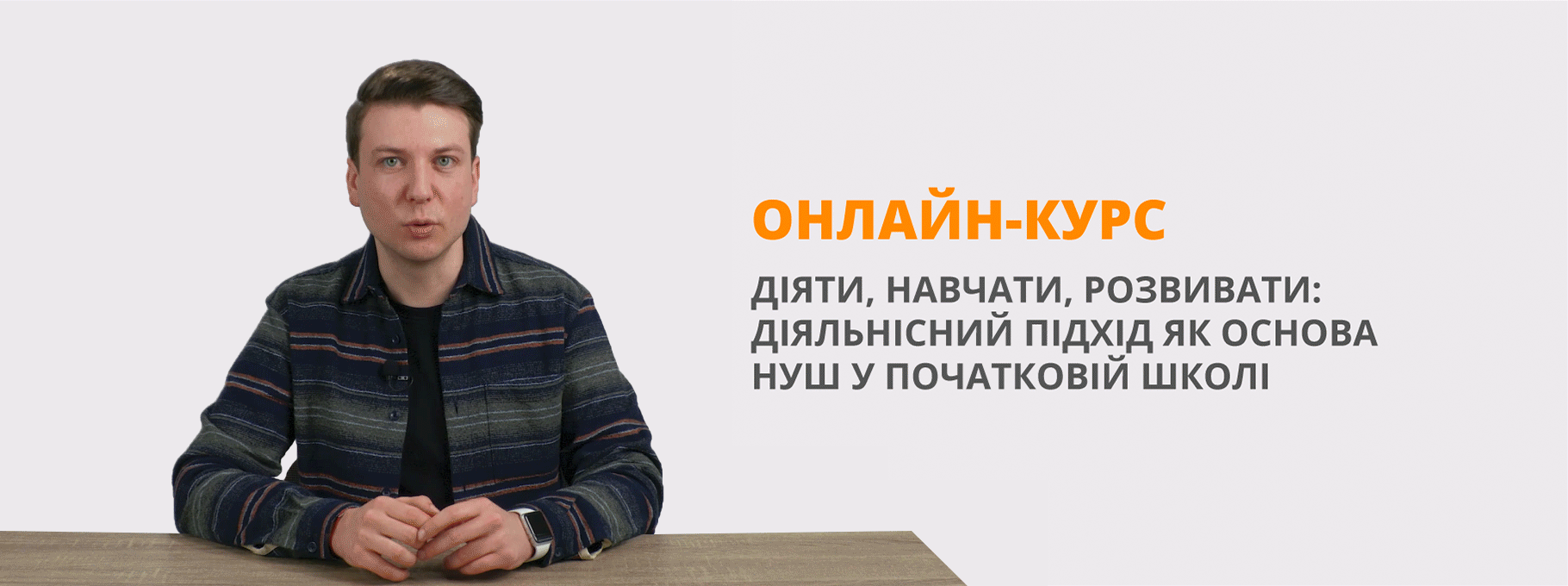Тести "Test your English"
Test your English
|
|
|
У збірнику зібрано матеріали, які можуть бути використані для перевірки сформованості навичок читання та аудіювання . Завдання розроблено у формі тестів, що виконуються шляхом правильного варіанту відповіді. Додаються також проблемні завдання на перевірку розуміння змісту тексту. Завдяки матеріалам посібника вчитель зможе зробити урок цікавим та інформативним.
Посібник рекомендований для вчителів англійської мови.
Зміст
Mr. Smith……………………………………………………………………………..2
Petrenko’s family……………………………………………………………………..2
My family…………………………………………………………………………….3
English meals…………………………………………………………………….......5
Lunch at school……………………………………………………………………….6
The place where I live…….………………………………………………………….7
The seasons in England………………………………………………………………8
The life of Jesus……………………………………………………………………....9
My family and friends……………………………………………………………….10
Animals………………………………………………………………………………11
A city life and a village life……….………………………………………………...19
The parrots…………………………………………………………………………...14
All seasons are beautiful……………………………………………………………..15
Clothes we wear……………………………………………………………………...17
Our English lesson…………………………………………………………………...18
Travelling…………………………………………………………………………….19
Jane’s day……………………………………………………………………………19
Easter is spring holsday……………………………………………………………...20
Winter and summer in Great Britain………………………………………………...21
Food and drinks……………………………………………………………………...22
Greenfield……………………………………………………………………………23
Mr. Smith
Listen to the text.
Mr. Smith lives in London. He is a police officer. At home Mr. Smith usually wears a shirt, trousers, a jacket, socks and shoes. But when he goes to work he puts on his police uniform. When it is cold he puts on a sweater. It keeps him warm during his night duties. He also puts on his boots. Then he puts on a police jacket or a raincoat and takes his police cap. When Mr. Smith comes home from work he always changes his clothes and puts his uniform into the wardrobe.
Test
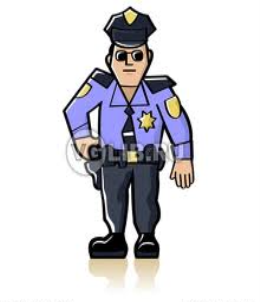 Put these sentences are true or false.
Put these sentences are true or false.
- Mr. Smith lives in Washington DC.
- He is a police officer.
- At home he usually wears a white shirt, a black suit and shoes.
- He also wears socks when he is at home.
- At his work he wears a police uniform.
- When it is cold he puts on a warm coat and a scarf.
- His warm sweater keeps him warm during his night duties.
- He also puts on his boots.
- He wears a police jacket and a cap.
- He also puts on a raincoat.
- When Mr. Smith comes home he changes his clothes.
- He never puts his uniform into the wardrobe.
Petrenko‘s family
We are the Petrenkos. Our family is not big. We are three. My name is Oleksander Petrenko, my wife`s name is Oksana Petrenko, and our son`s name is Victor. We came from Poltava, a beautiful Ukrainian town. I am 34 and I am a doctor. I work in a hospital. My wife is 31, she is a teacher. She teaches Maths at school. Besides, she has got a lot of work about the house. This is why she usually gets up very early. And our son is quite a child. He is only 6. He goes to a kindergarten, but he is rather smart and clever boy. His hobby is drawing. He draws everything he sees: trees and houses, dogs and cats, horses and cows, flowers and cars. He can read already and he wants to go to school. My hobby is swimming. I swim in the river, in the lake, in the sea in summer, and in the swimming-pool in winter. It is a useful and pleasant kind of sport. My wife`s hobby is cooking. We like her hobby because she cooks very tasty cakes and apple pies for us.
- How many members are there in the family?
- 5 b) 3 c) 4
- Where do they live?
- in America b) in Ukraine c) in Russia
- What is father`s profession?
- Teacher b) doctor r c) worker
- What subject does Oksana teach at school?
- English b) History c) Maths
- Who is their child?
- Girl b) boy
- What does he draw?
- Hobby b) everything he sees c) mother
-
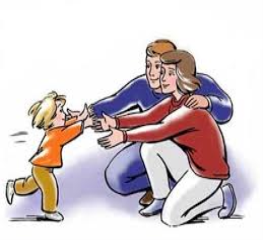 What is father`s hobby?
What is father`s hobby?
- Cooking b) swimming c) drawing
- Who goes to the swimming-pool?
- Son b) mother c) father
- Who hobby is cooking?
- Victor b) Oleksandr c) Oksana
- What does she cook?
- Soup b) cakes and soup c) cakes and pies
- What is the surname of the family?
- Petrenkos b) Johnsons c) Smith
- Where do they come from?
a) Kyiv b) Lviv c) Poltava
Listen, try to guess the words in bold. Then draw your family tree!
My Family
Hello! My name is Nick Steward. I live in the USA, California. I’m 13 years old. I am a pupil of the 6th form.
I have a big family. These are: mother, father, sister, brother, grandparents, aunt, uncle and 2 cousins.
My mother’s name is Ally, she is 35, she is a doctor. My father’s name is Peter, he is 40, he is a mechanic.
My little sister’s name is Nanni, she’s 5 years old. My brother George is older, he’s 15 years old, he studies at the 9th form.
My grandparents are: granny Maria and grandpa Charles. They are pensioners.
My aunt Fiona is 28 years old, her husband (my uncle) Tom is 30. They have two children – a boy and a girl – Philip, he’s 4, and Lizzie – she’s 1 year child.
I love my family very much!
![]()
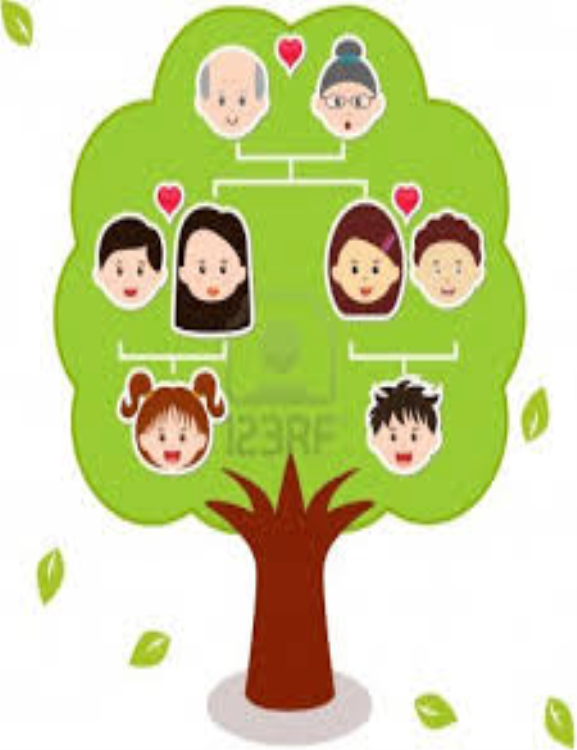
English Meals
The English take four meals a day: breakfast, lunch, tea and dinner or supper. In England breakfast time is between seven and nine, lunch time is between twelve and two, tea is between four and five and dinner or supper time is between seven and ten.
In some English houses lunch is the biggest meal of the day – they have meat or fish, vegetables, fruit or pudding. Some people who go out to work have sandwiches and coffee.
In the afternoon, at tea time the English, as you know, like to have a cup of tea with milk. Some Englishmen have their dinner late in the evening. For dinner they have soup, fish or meat, vegetables, pudding and fruit.
For supper they usually have a glass of milk and a cake or a cup of tea and a sandwich.
But there are people who like to have some more things to eat for supper – cold meat or fish. Then they usually try to take a good walk after supper: “after dinner sleep a while, after supper walk a mile”, the English proverb goes.
Now answer questions:
- How many meal do the English have a day? What are they?
-
 What time do the English have breakfast?
What time do the English have breakfast?
- What time do the British have lunch?
- What time do the British have dinner or supper?
- What do they have for lunch?
- How do they like to drink their tea?
- What do they have for dinner?
- What do they have for supper?
- What does the English proverb go?
Agree or dissagree:
• The English have four meals a day.
• In England breakfast time is between nine and twelve.
• Lunch is the biggest meal of the day in all English families.
• The English like to have tea with milk.
• The English proverb says: “ After supper sleep a while, after dinner walk a mile”.
Complete the sentences:
- The English take ______ meals a day.
- In England breakfast time is between ___ and _______.
- In some English houses lunch is the ___ meal of the day.
- For dinner they have _____, fish or ____, vegetables, _________ and ________.
- “After _______ sleep a while, after _____ walk a mile”.
Think about the plan to the text:
Lunch at School
Twelve o`clock is the time for lunch in our school. Children are running to the school cafe. They are thirsty and very hungry. Today they have some potatoes and some fish, a glass of tea and some biscuits for their lunch. There are also different kinds of burgers, pizzas and salads. Pupils can buy bottles of water, cans of lemonade or cartons of juice. My friend Pete likes to buy a bar of chocolate or a box of sweets. We like to have lunch at school.
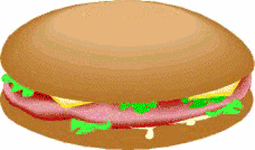
Discussion:
What is this text about?
Where do children have their lunch?
Are they thirsty and hungry?
What can they eat at the school cafe?
What can they drink there?
Test
1. Children can have lunch at …
a. School b. home c. work
2. They have lunch at …
a.12 o'clock b. 1 o'clock c. 2 o'clock
3. The pupils … after the lessons.
a. Go home b. do homework c. are hungry
4. Today they have …
a. Some potatoes and some fish
b. Some rice and some salad
c. Some porridge and some meat
5. Pupils can buy …
a. Flowers b. bottles of water c. some butter
6. My friend Pete likes to buy…
a. Oranges b. chocolate or sweets c. juice
7. We like to have lunch at …
a. Home b. the lesson c. School
Take your neighbour`stest paper and give yours instead and check.
1.a 2.a 3.c 4.a 5.b 6.b 7.c

The place were I live
Listening
Hello! I am a guide. My name is Olha. You are in the my native village. Popivka is a not big village of Lypovets district Vinnytsa region on a small river Sobka.
According to the document the village was founded in 1840-1848.
The earl Strutynskiy came to Peterburh and his son sold their village. The large part of land bought the church , that is why land was name popivska, in the future – Popivka.
One of the famous place is Church of St.Paraskevy. It was restored in 1994. Not far from this place are the school,the Palace of Culture. Certainly there is the monument to the Soviet soldiers , who defended our village. In this tomb there are more than 200 soldiers , from all the regions of the Soviet Union.
One kilometres from the village there is a obelisk. On this historical place Hryhoriy Tkachenko was repeated heroic deed of Olexandr Matrosov.
Tkachenko was born in the village Krasna Yaruha in Russia. But was killed on Ukrainian land in the fight against enemies in the days of the Great Patriotic War.
Don t forget that Taras Shevchenko - the greatest Ukrainian poet , may be visited our village in 1856, when he studied history, painted and wrote poetry. He was visited a small village Pisochyn, Zhornyshchi, next Nemyriv and Tulchyn too.
Post-Listening
Tourist ask questions how to get these famous places.
Use there table
|
Ask |
Tell |
|
Turn right(left)… Cross the street… Go along the street… It is not far from… The centre… |
The Seasons in England
 English families like to spend their holidays and the weekends in the countryside. The English countryside is like a carpet of many flowers in every season. In spring and summer the fields, the meadows and the forests are light green and dark green. The gardens are red, blue, yellow and white with flowers. In autumn the leaves on the trees change their colour from green to yellow, brown, red and orange. The English summer is never very hot and in winter it is not very cold. Spring and autumn are cool. Cold wind blows in winter from the sea, in summer the winds are cool. There is little snow in winter, and it never stays on the ground for long. There is little snow in winter, and it never stays on the ground for long. But there is much rain in England all the year round. The weather is very changeable. The grass in the mountains is green all the year round. That’s why you can see many cows and sheep in the meadows. English children like to play football very much. They can play football even in winter because the football fields are always green. All children like summer best of all because it is the season of their holidays. They can go to the seaside, play in green parks and walk in the mountains.
English families like to spend their holidays and the weekends in the countryside. The English countryside is like a carpet of many flowers in every season. In spring and summer the fields, the meadows and the forests are light green and dark green. The gardens are red, blue, yellow and white with flowers. In autumn the leaves on the trees change their colour from green to yellow, brown, red and orange. The English summer is never very hot and in winter it is not very cold. Spring and autumn are cool. Cold wind blows in winter from the sea, in summer the winds are cool. There is little snow in winter, and it never stays on the ground for long. There is little snow in winter, and it never stays on the ground for long. But there is much rain in England all the year round. The weather is very changeable. The grass in the mountains is green all the year round. That’s why you can see many cows and sheep in the meadows. English children like to play football very much. They can play football even in winter because the football fields are always green. All children like summer best of all because it is the season of their holidays. They can go to the seaside, play in green parks and walk in the mountains.
Post-reading task. Choose the correct variant.
- English families like to spend their holidays and the weekends in the countryside/at the seaside.
- Cold wind blows in winter from the sea/from the ocean.
- There is little snow/rain in winter.
- The weather is changeable/fine.
- The grass in the mountains is green all the year round/in summer.
- You can see many cows and sheep in the meadows/in the countryside.
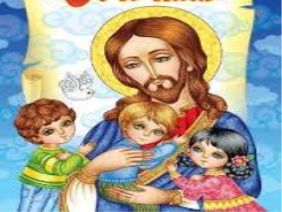
The Life of Jesus
Everyone know something about the life of Jesus. As a boy he lived in the small town of Nazareth. When he was about thirty years old he began teaching and preaching and healing the sick. His fame spread quickly.
Soon had twelve disciples or followers. Most of them were fishermen. They went with Jesus and learned from him as he walked through the countryside talking to the people.
Crowds gathered to hear Jesus preach. They found new hope and strength in the words he spoke. Many people began to say that he was the king or Messiah; they had been waiting for.
True or False
1. Jesus lived in the small town of Nazareth.
2. Jesus began teaching, when he was forty years old.
3. Jesus had ten disciples.
4. Many people began to say that he was the king or Messiah.
5. On Friday evening Jesus ate the Passover supper in Jerusalem.
Answer the questions
1. When was Jesus born?
2. What did he begin to do when he was thirty years old?
3. How many disciples did he have?
4. When did Jesus eat in the Passover supper?
5. What commandment did he give his disciples?
My family and friends
- My name is Teresa and I’m from Brazil. I’m 12. I’ve got two sisters. I love sport. My favourite sport star is Revaldo. I can play football but not very well. I have tennis classes twice a week. I’m interested in collecting badges. My favourite music is soul. I like dancing very much.
- My name is Paul. I’m thirteen. I’m from Sidney in Australia. My mother and father are engineers. My sister is a student, she is 18. My hobby is photography. I like taking photos of animals. I have got lots of photos of koala bears! I’m crazy about hard rock. I don’t like watching TV. I love sport. My friend and I play basketball every day. We go surfing too. I also like computers. I have got many interesting games.
- I’m Jane. I’m from the USA. I live in Los Angeles. It’s great! I like it. I study at school. I’m twelve. My hobby is playing the piano. I love music. My favourite music is rock’n’roll. I’m crazy about Elvis. He is the best! I play tennis. I have three classes every week. My family – dad and mum – often go to watch tennis competitions. In the evening I like to play computer games.
- My name is Mykola. I’m from Ukraine. I’m thirteen. I have a sister and a brother. They are schoolchildren too. I like collecting different things. I’ve got a big collection of stamps. They are fantastic. I like reading books about travelling. My favourite sports are diving and football. I like listening to rap.
Read the texts and fill in the table:
|
Name |
Age |
Country |
Hobby, favourite activities |
Favourite music |
Favourite sport |
|
|
|
|
|
|
|
|
|
|
|
|
|
|
|
|
|
|
|
|
|
Animals
MATCH THIS!
 Read the details in each paragraph below. To the right of the paragraphs are some pictures. Draw a line from each paragraph to the animal it describes.
Read the details in each paragraph below. To the right of the paragraphs are some pictures. Draw a line from each paragraph to the animal it describes.
1. The front legs of this animal are short. Its back legs are much longer. Its tail is long and thick. The female has a pouch in which she carries her young.
2.. This animal is a member of the cat family. It is large and powerful. It has a tail. The male also has a mane, and the mane is shaggy.
3.. This animal has a long bushy tail. Its fur is thick. A small animal, it lives in trees.
4. This animal is large and strong. It has a flowing mane and a tail People often ride on it.
5. This animal is small and has long ears. Its fur is soft. It has a short tail.
Read the texts about
Pros and Cons of living in a city/village

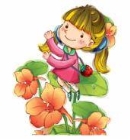










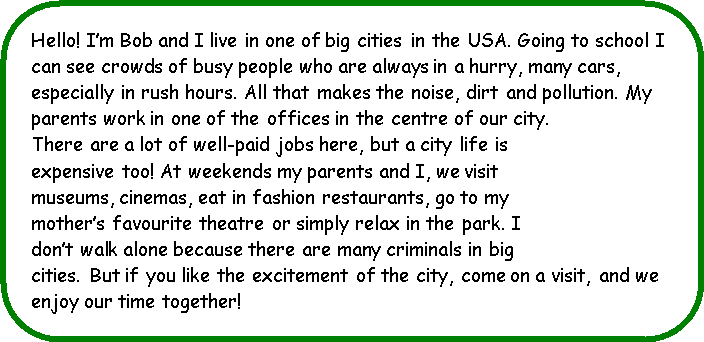
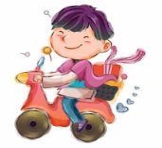
![]()
![]() 3. Say whether the statements are true or false
3. Say whether the statements are true or false
1. Living in a city you suffer from noise and rubbish.
2. Actors, even theatres, can give their performances just in a village you live.
![]()
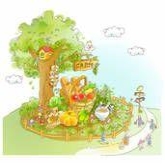 3. In big cities there are a lot of department stores, where you can buy all you need.
3. In big cities there are a lot of department stores, where you can buy all you need.
![]() 4. Living in a country you can choose any public transport.
4. Living in a country you can choose any public transport.
![]() 5. City flats are often very expensive.
5. City flats are often very expensive.
6. It takes you a lot of time to get to your job in a village.
![]()
4. Complete the chart
|
|
Advantages |
Disadvantages |
|
A village life |
|
|
|
A city life |
|
|
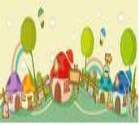
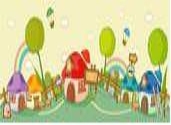

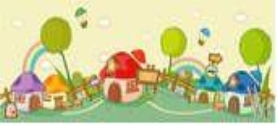
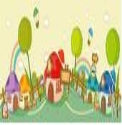

The parrots
Parrots live in the forests of South America, where summer lasts all the year round, where leaves are always green. The parrots make their homes in the forest, because there they can find shade in the heat of the day.
Parrots eat fruit and nuts. They like wild cherries best of all. They like them because of the stones. The beak of the parrot is very sharp and it cracks these stones easily.
Parrots like to bathe very much. They fly about till they find water. They dip into the water and splash it over their feathers. Then they sit in the sun till they are dry. In the middle of the day the heat becomes very great. Then parrots fly in the deepest shade. They sit in the trees and sleep. But in the evening, when the sun is going down, they wake up. They eat fruit, go to the water and bathe again. Only after that they go to the rest for the night.
People can tame parrots. The parrot is a very interesting pet, because it can talk.
I. True or false
__1. Parrots live in the fields.
 __ 2. In South America winter lasts all year around.
__ 2. In South America winter lasts all year around.
__ 3. Parrots like to bathe.
__ 4. In the middle of the day it is hot.
__ 5. Parrots like to fly in the middle of they day.
__ 6. People can tame parrots.
II. Finish the sentences with the suitable words.
- Parrots live …
a) North America; b)South America; c)Africa
- Parrots eat …
a) corn; b) nuts; c) fish
- When it’s hot they …
a) sleep; b) fly; c) bathe
- Parrots wake up …
a) in the morning; b) in the afternoon; c) in the evening
- Before going to rest for the night parrots …
a) play; b) fly; c) bathe
- The parrot is very interesting pet because it can …
a) play; b) talk; c) sign
III. Answer the question
- How long does the summer last there?
- What fruit do parrots like best of all?
- How long do parrots sit in the after bathing?
IV. Imagine you have a parrot at home. Describe it, what it likes to do and to eat.
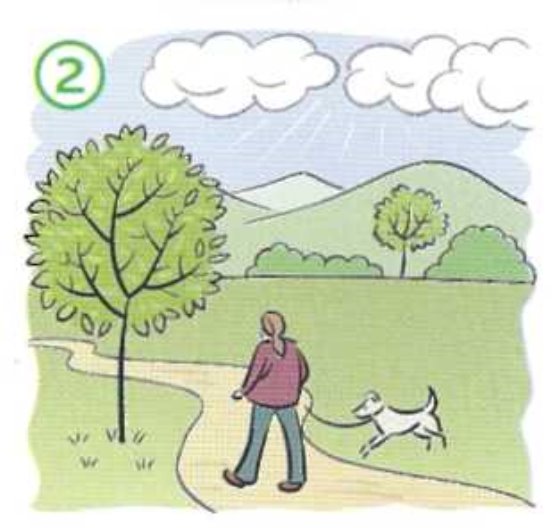
ALL SEASONS ARE BEAUTIFUL
Teacher: Today we shall speak about seasons. There are four seasons in a year: spring, summer , autumn, winter, What is your favourite season?
Tom: My favourite season is autumn. It’s a beautiful season. The leaves in the trees are red, yellow, brown and green. It is warm in September. I can go for a walk. On the first of September I am glad to see my friends at school after the long summer holiday. In autumn there are a lot of vegetables and fruit. I like sweet pears.
Alice: I don’t like autumn. It’s a dull season. I don’t like when it rains. In October it is cold and it often rains, and we can’t go for a walk. I like summer. Summer is a bright season. The trees are green. It’s hot and I can swim in the river. I can play outdoors all day long. And I don’t go to school.
David: And my favourite season is winter. Winter is beautiful. The trees are white with snow. There is a lot of snow in the streets and in the parks. My friends and I can play snowballs and hockey. But most of all I like to ski.
Susan: I don’t like winter. It’s so cold in winter. It often snows. The sky is grey. The day are short and the nights are long. I like spring. The sun often shines, the sky is blue , birds singsong. In May the trees and grass are bright green. There are many beautiful flowers in May.
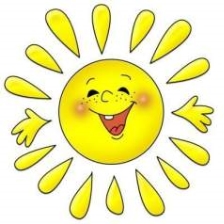 Teacher: Well, children, I think all seasons are good and beautiful. Everything is good its season.
Teacher: Well, children, I think all seasons are good and beautiful. Everything is good its season.
I. Write the correct name:
1. ________likes snow.
2. ________doesn’t like rain.
3. ________likes sunshine.
4. ________likes swimming in hot days.
5. ________likes meeting friends after holidays.
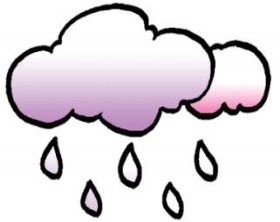 6.________ likes colourful leaves.
6.________ likes colourful leaves.
II. True or False
__1. It snows in winter.
__2. October is an autumn month
__3. It’s hot in winter,
__4. We start school on the first of October.
__5. You can eat pears in autumn.
__6. The trees are bright green in May.
III. Answer the questions.
- How many seasons are there in a year?
- How many month are there in each seasons?
- When can you play snowballs?
- When can you swim in the river?
- When can you eat many taste fruit and vegetables?
- When can you see the first flowers?
IV. Describe your favourite season and weather.
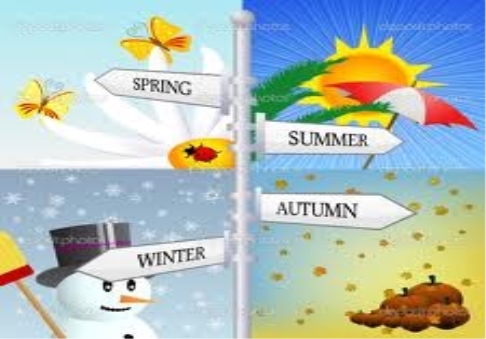
Clothes We Wear
Clothes give a lot of information about us. For example, we wear clothes to keep us warm because unlike animals we do not have a protecting covering of hair. But in different life situations we dress in clothes of different colours, style and material; for official parties men wear dark suits and a tie (or a bowtie) and I women wear long evening dresses and jewellery. There are some strict rules about clothes style. We do not, for instance, wear football boots with a dinner jacket, or jeans to work in a bank. A farmer who takes care of animals or works in a field will not wear a suit and a bowtie. There are many schools where schoolchildren must wear a school uniform. Of course, not all boys and girls like this rule. If you go to the beach on a sunny day, you usually put on a T-shirt, shorts and sandals because you want to feel comfortable. Our clothes say something about our character and our positive or negative attitude to life.
Listen the text and tick True or False with these statements.
- Animals' clothes are their hair.
- We wear different clothes on different occasions.
- Men wear jeans and T-shirts at the official parties.
- We can't wear training shoes with a long evening dress.
- Very few schools have a school uniform.
- All schoolchildren enjoy wearing their school uniform.
- The colour of our clothes shows our world
Answer the questions.
Why do people wear different clothes?
How is the farmer usually dressed when he works in a field or on a farm?
What clothes do you usually wear to school?
What do people usually wear when they go to the beach?
In what clothes do you feel comfortable?
OUR ENGLISH LESSON
We have our English on Mondays and Thursdays.
Al the English lesson we read and write in English. We speak English, too. We read and learn new words. We read texts, too. We usually write on the blackboard. I like to go to the blackboard and write letters and words. We always speak at the lesson. We like to speak English. We speak about our school, our lessons, our family and friends.
Every day when the lesson begins, the teacher comes in and says, "Good morning, children!"
And we say "Good morning!"
Then the teacher says, "Sit down, please!" And we sit down and open our books.
 We all like our English lessons.
We all like our English lessons.
Match the words with their transcription and Ukrainian
Equivalents from the box
speak, books, teacher, like, lesson, blackboard
1) We sit down and open our ___________________
2) We _______________about our school, our lessons and our friends.
3) We all______________.our English lessons.
4) At the English____________we read and write English.
5) The______________says "Sit down, please".
6) I like to go to the_______________and write letters and words.
Answer the questions.
- When do they have their English?
- What do they do at the English lesson?
- What do they speak about?
- Do the children like to speak?
- Do they write on the blackboard?
- What do they write on the blackboard?
- What does the teacher say when the lesson begins?
Travelling
A lot of people in the world like travelling on holidays. They travel to see other countries, modern cities and the ruins of ancient towns. It is exciting to learn new things, different people, their nationals custom] and the way of life.
Some people enjoy visiting big cities with museums, art galleries, shops and restaurants. Another group of people prefers a quiet holiday by the sea or in the mountains, walking, bathing and getting sun burnt.
People usually take a camera with them and make photos of all interesting views. Sometime later these photos will remind them of the happy moments which they had on their holidays.
People can travel in different ways. They can do it by train, by plane, by ship, by bus, and by car. All of these means have positive and negatives sides. And people choose one according to their plans, possibilities and destinations.
Fill in the gaps.
- People t__ to see some new places.
-
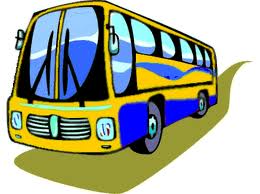 Some people e__ spending their holidays in big noisy cities.
Some people e__ spending their holidays in big noisy cities.
- It's so nice to have a q____ holiday by the s__.
- As a rule, people take a c_____ to make photos.
- These photos can r____ them of the happy time.
- There are d__________ways of travelling.
- Each of them has p____and n_______moments.
Answer the questions.
- Where can people travel?
- Why can people spend their holidays visiting big cities?
- Why do people usually take a camera with them?
- What ways of travelling can you name?
JANE'S DAY
Jane is a schoolgirl. She goes to school every day. Jane has five or six lessons. When the lessons are over, Jane goes home.
When she comes back home, she puts away her books and has dinner. Jane is hungry after school and she eats well. For dinner she usually has soup, fish or meat with potatoes and fruit. When she finishes her dinner she washes the dishes.
After dinner Jane cleans the room and then goes to the yard to play with her friends. They play ball, run and jump.
Then Jane comes home and does her homework. When her homework is ready, she reads books or watches TV. Then all the family has supper.
At half past nine Jane says "Good night" to her parents and goes to bed.
Put the sentences in the correct order.
a) After dinner Jane cleans the room and then goes to the yard to play with her friends.
b) At half past nine Jane says "Good night" to her parents and goes to bed.
c) When she comes back home, she puts away her books and has dinner.
d) Then Jane comes home and does her homework.
e) Jane is a schoolgirl. She goes to school every day.
f) For dinner she usually has soup, fish or meat with potatoes and fruit.
Make up questions to the sentences starting with the words in brackets.
- Jane is a schoolgirl. (Who)?
- Jane has five or six lessons. (How many)?
3) Jane is hungry after school. (Who?)
4) After dinner Jane goes to play with her friends. (When ?)
5) They play ball, run and jump. (What?)
6) When her homework is ready, she reads books or watches TV. (What?)
7) At half past nine Jane goes to bed. (When?)
EASTER IS A SPRING HOLIDAY
Easter is a spring holiday. It is a Christian holiday. It is always on a Sunday.
People go to church on Easter Sunday. They go there at sunrise. They sin and pray. They think about a new life after death. It is a very happy day. Flowers chickens, eggs are all signs of Easter. They are signs of new life.
In England rabbits are signs of Easter, too.
Little children believe in the Easter Bunny. It has many baskets with Easter presents in it, coloured eggs and candy. On Easter morning, the children hunt for their baskets.
Children like to colour eggs.
Families eat a big dinner on Easter Sunday. People in Ukraine eat Easter cakes (paskhi) and coloured eggs (khrashenki). All are happy.
Choose the best answer.
 1) Easter is a ... holiday.
1) Easter is a ... holiday.
a) summer b) spring c) autumn
2) It is always on a ... .
a) Sunday b) Saturday c) Friday
3) Christians go to ... on Easter Sunday.
a) church b) school c) park
4) English children believe in Easter....
a) Flower b) Bunny c) Fox
5) Children like to colour... .
a) basket b) eggs c) picture books
Put "+" next to the true sentences and "-" next to the false ones.
1) Easter is a summer holiday.
2) Easter is a christian holiday.
3) It is always on Monday.
4) People go to church at midnight.

WINTER AND SUMMER IN GREAT BRITAIN
It is winter in Great Britain in November, December, January and February. It is cold all the time. Sometimes it is also wet and windy. People wear sweater coats, hats and gloves.
In December, the days are very short and the nights are very long. The sun comes up at 8 o'clock in the morning. It goes down at 4 o'clock in t afternoon.
It is summer in June, July and August. It is usually warm. Sometimes it very hot and sometimes it is cool and wet. When it is not cold, people wear T-shirt shorts and sandals.
In June, the days are very long and the nights are very short. The sun comes up at 4 o'clock in the morning. It goes down at 9 o'clock in the evening.
1. Put "+" next to the true sentences and "-" next to the false ones.
 1) It is winter in Great Britain in November.
1) It is winter in Great Britain in November.
2) It is cold from time to time in winter.
3) People do not wear warm clothes in winter.
4) The sun comes up at 8 o'clock in the morning in winter.
5) It is summer in June, July and August in England.
6) In summer the sun goes down at 4 o'clock in the evening.
Answer the questions.
- When is it winter in Great Britain?
- What's the weather like in winter?
-
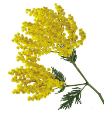 How long are the days in winter?
How long are the days in winter?
- What do people wear in winter?
- When it is summer in Great Britain?
- What's the weather like in summer?
- How long are the days in summer?
- What do people wear in summer?
Food and Drinks (English Meals)
The Englishmen usually have four meals a day: breakfast, lunch, tea (5 o'clock) and dinner. Breakfast can be a full "English breakfast" of cornflakes with milk and sugar, or bacon and eggs, toast and marmalade, tea or coffee. Some people have just a cup of tea or coffee with a toast. This is usually called "continental breakfast". At midday everything is stopped for lunch. Most offices and small shops are closed for an hour and people visit cafes, coffee bars or restaurants for lunch. Factory workers usually eat in their canteens. The Englishmen like what they call "good plain food". They must know what they are eating. Usually they like steak, roast beef, Yorkshire pudding, fish and chips. Afternoon tea is at about 5 o'clock. It is a cup of tea with cakes or biscuits. Dinner is usually at 7 o'clock. The main course can be fish or meat (roast beef) with a lot of vegetables. The next course is something sweet, such as fruit pie. Last of all there may be cheese, often with biscuits. The English are fond of tea. They like to have "a nice cup of tea" six or eight times a day, sometimes even more.
Correct the sentences.
- The English people have five meals a day._____
- Lunch is usually in the afternoon.____________
- The Englishmen have their lunch at their offices.________
-
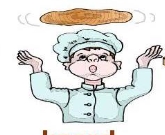 "Good plain food" is fast food._____________
"Good plain food" is fast food._____________
- Dinner is at about 9 o'clock.____________
Choose the correct item.
- The most popular tea is at ... o'clock.
- four; 2. five; 3 seven.
2. A cup of tea or coffee with a toast is called ... breakfast.
1. American; 2. Australian; 3. continental.
3. Lunch is...
1. in the morning; 2. at midday; 3. in the afternoon.
4. "Good ... food" is steak, roast beef, fish and chips.
1. plain; 2. spicy; 3. delicious.
5. The ... course is fish or meat with vegetables.
1. second; 2. dessert; 3 main.
Make up questions starting with the words in brackets.
- Most of Englishmen have a full "English breakfast". (What?) ___________________
- Most of people eat their lunch at cafes, coffee bars or restaurants. (Where?)________
- Factory workers prefer to have lunch in their canteens. (Who?) __________________
- At five o'clock Englishmen have a cup of tea with cakes. (When?)________________
GREENFIELD
Greenfield is a small village in England. It's not far from Manchester. There are five buses to Manchester every day, but there is only one train. There are not many people on the train at five o'clock in the morning.
The village is nice. The church is in the middle of the village on the square There are many other buildings in the square. There is a bank, a post office a bus station and a police station. The library is behind the police station. Then is a small river in Greenfield and there is a bridge across the river.
There are two garages in front of the bridge. It's a small village, isn't it?
There is no traffic, no noise, and no pollution.
Answer the questions.
- Where is Greenfield?
- How many buses are there to Manchester?
- Are there many people on the train?
- What is in the middle of the village?
- What other buildings are there in the square?
- Where's the library?
- What is there in front of the bridge?
- Is it a nice village?
Complete the following sentences.
- Greenfield is situated in__________
- There is only one train into__________
- The church stands in the middle of__________
- The library is___________
- There are__________garages in front of the__________
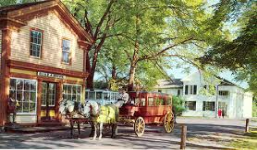

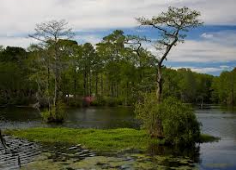
СПИСОК ВИКОРИСТАНИХ ДЖЕРЕЛ
- Готуємося до зовнішнього незалежного тестування: Збірник тестових завдань з англійської мови. – Тернопіль: Мандрівець, 2007.- 108 с.
- Кіктенко Т.М. Англійська мова. Тести з читання та аудіювання. 5-11 класи. – Х.: ТОРСІНГ ПЛЮС, 2005.- 48 с.
- Коновал З.Й., Адамовська Л.М. Англійська мова. Збірник диктантів, текстів для переказів та аудіювання. 5-11 класи. – Тернопіль: Навчальна книга, 2001.- 80 с.
- Кропачова О.П. Тести для тематичного оцінювання навчальних досягнень учнів за видами мовленнєвої діяльності шкіл з поглибленим вивченням англійської мови до НМК „Welcome to English Study” (автор О.Д. Карп'юк). – Тернопіль: Видавництво Карп'юка, 2005.- 48 с.
- 11. Науково-методичний журнал «Англійська мова та література»
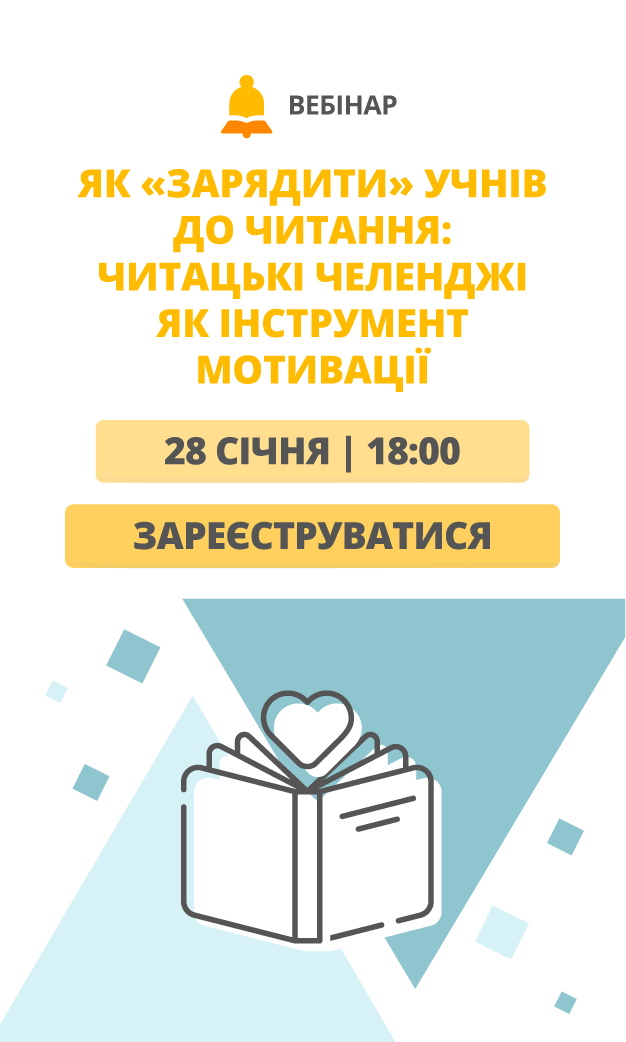

про публікацію авторської розробки
Додати розробку
